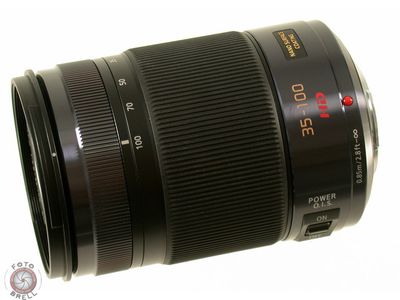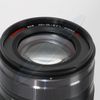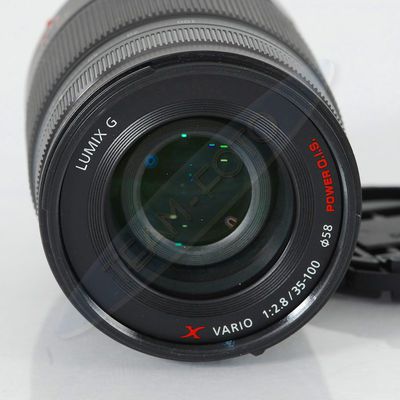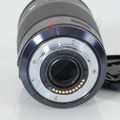Panasonic LUMIX G X VARIO 35-100 mm F2.8 ASPH O.I.S.: Unterschied zwischen den Versionen
K (Text und Links eingefügt) |
K (Text und Links eingefügt) |
||
| Zeile 7: | Zeile 7: | ||
Panasonic-Code: H-HS35100E | Panasonic-Code: H-HS35100E | ||
| − | Es gibt zwei Varianten, die sich nur leicht unterscheiden sollen ([https://www.oly-forum.com/forum/kameras-objektive/panasonic-lumix-g-x-vario-2835-100-mm-alte-oder-neue-version Quelle]): | + | Es gibt '''zwei Varianten''', die sich nur leicht unterscheiden sollen ([https://www.oly-forum.com/forum/kameras-objektive/panasonic-lumix-g-x-vario-2835-100-mm-alte-oder-neue-version Quelle]): |
:''"Die optische Leistung ist wohl die gleiche wie beim Vorgänger, das Gehäuse hat jetzt ein mattschwarzes Finish (im Gegensatz zum Vorgänger, das je nach Lichteinfall einen violetten Schimmer zeigte) und Panasonic hat das Objektiv wohl vorwiegend in Hinsicht auf den Dual-IS der neuen Bodys optimiert"'' | :''"Die optische Leistung ist wohl die gleiche wie beim Vorgänger, das Gehäuse hat jetzt ein mattschwarzes Finish (im Gegensatz zum Vorgänger, das je nach Lichteinfall einen violetten Schimmer zeigte) und Panasonic hat das Objektiv wohl vorwiegend in Hinsicht auf den Dual-IS der neuen Bodys optimiert"'' | ||
Version vom 14. Juni 2018, 15:30 Uhr
Beschreibung
Ein Tele-Zoomobjektiv von Panasonic für die Pen-Kameras (MFT).
Vergleichbar einem 2.8/70-200 mm-Objektiv im Kleinbildformat ist es ein Vertreter der lichtstarken Zoom-Objektive.
Panasonic-Code: H-HS35100E
Es gibt zwei Varianten, die sich nur leicht unterscheiden sollen (Quelle):
- "Die optische Leistung ist wohl die gleiche wie beim Vorgänger, das Gehäuse hat jetzt ein mattschwarzes Finish (im Gegensatz zum Vorgänger, das je nach Lichteinfall einen violetten Schimmer zeigte) und Panasonic hat das Objektiv wohl vorwiegend in Hinsicht auf den Dual-IS der neuen Bodys optimiert"
Zitate
Ein Zitat aus dem Testbericht in photozone.de:
- "The Panasonic Lumix G X 35-100mm f/2.8 Power OIS is an expensive tele zoom lens but it lives up to its high reputation. From a user perspective, there is little to complain. It is dead sharp in the image center and pretty good in the border region. Since distortions are auto-corrected, there is nothing to worry about here. You may spot some light falloff in the corners at f/2.8 but it's not overly disturbing and gone from f/4 onward. Lateral CAs are quite low. The quality of the bokeh - a major aspect of a fast lens - is very good. The background blur is beautifully rendered and there's almost no bokeh fringing. On the downside the less critical foreground bokeh is slightly busy and highlight discs aren't totally perfect. When looking behind the scenes - thus into uncorrected RAW files - you can spot a fairly high albeit not excessive degree of distortion at 35mm. Other than that there're no issues in the original characteristic of the lens."
"The build quality of the lens is excellent thanks to high quality materials, weather sealing and a constant physical length throughout the zoom range. The focusing speed is high and essentially noiseless so the AF may also be usable for movies to a certain degree. Panasonic's "Power OIS" (image stabilizer) is well proven by now. It may not excel like the Canon or Nikon counterparts but it can give you some extra potential when shooting without a tripod in low light situations."
"All-in-all a very capable lens and as such "Highly Recommended"!"
Ein Zitat aus dem Test in traumflieger.de:
- "Das Lumix G Vario 35-100mm/2,8 OIS kann mechanisch überzeugen und ist mit 360gr. federleicht - einzigartig in dieser Lichtstärkenklasse!
Vorteilhaft ist der Innenzoom und Innenfokus. Es ändert sich beim Zoomen daher weder die Baulänge noch rotiert die Frontlinse beim Fokusvorgang. Erfreulich auch, dass es parfokal arbeitet und die Schärfenebene bei Brennweitenänderung konstant hält - dies ist z.B. für manuell fokussierende und szenisch arbeitende Videofilmer wichtig. Das Bokeh wirkt auf uns gefällig, nur Spitzlichter werden abgeblendet mit 7 Lamellen doch etwas wabenförmig gebrochen - Spitzenobjektive bei DSLR nutzen hier meist 8 oder 9 Lamellen.
er Lieferumfang mit Transport-Beutel, praktischem Innen-Snap-Schutzdeckel und enthaltener Streulichtblende (für den Transport an der Linse umsteckbar) sei lobenswert erwähnt.
Optisch ist das Lumix-Objektiv wirklich praxistauglich und bringt in allen Brennweiten die nötige Auflösung im wichtigen Bildzentrum bereits bei Offenblende. Im von uns getesteten RAW-Format mit Adobe Lightroom sind auch die übrigen Qualitätskriterien wie geringe Verzeichnung und Farbsaumfreiheit gegeben. Auch Linsenflecken bzw. Geisterbilder sind dank der Nanovergütung nur sehr gering ausgeprägt.
Allein die Randunschärfen unterhalb der Endbrennweite stören uns doch etwas. Das kostet dem Objektiv in unserer Wertung einen Stern, zumal der Anschaffungspreis oberhalb von 1.000 Euro als anspruchsvoll bezeichnet werden muss. Insgesamt erreicht es 4 von 5 Sternen. Berücksichtigt man, dass es derzeit konkurrenzlos für den Micro-Four-Thirds-Standard - und spiegellose Systemkameras überhaupt - ist, kann man ihm durchaus noch 4,5 Sterne zugestehen. Panasonic sollte hier dennoch langfristig über Rand-Optimierungen nachdenken, um auch professionellsten Ansprüchen in allen Brennweitenstufen nachzukommen."
Ein Zitat aus dem Vergleich M.ZUIKO DIGITAL ED 12-40 mm F2.8 Pro und Panasonic LUMIX G X VARIO 35-100 mm F2.8 Asph OIS in mirrorlessons.com:
- "s you might have suspected, there is very little to say against either of these standard zooms. We’ve owned the M.Zuiko 12-40mm since its release and have never been disappointed by its performance. Of all the Micro Four Thirds lenses we own, it is probably the one that gets the most use due to the versatility of its focal range, close-focussing capabilities and excellent build quality. The Lumix 12-35mm, on the other hand, has the advantage of being smaller and lighter. What’s more, it incorporates excellent optical stabilisation, which is essential if you are using a non-stabilised body. It suffers more than the 12-40mm from chromatic aberration but today’s software programs are perfectly capable of removing the worst of it."
"Personally speaking, I am happy that we chose the M.Zuiko 12-40mm f/2.8 even though it is larger and heavier than the Lumix. The close-focusing capabilities and slightly larger focal range come in handy all the time when I am shooting product shots or when I go out to take pictures for the website, and it is nice to have that extra sharpness at the fastest aperture. Plus, the fact that we only own stabilised bodies means that we don’t have to worry about using slow shutter speeds with this lens. That said, if I didn’t own a stabilised body – and that means most cameras in the Lumix range – the 12-35mm would be a no-brainer."
Technische Daten
| Hersteller: | Panasonic | Bezeichnung: | Panasonic LUMIX G X VARIO 35-100 mm F2.8 Asph OIS | |||||||||
|---|---|---|---|---|---|---|---|---|---|---|---|---|
| Brennweite: | 35-100 mm | Herstellungszeitraum: | 2012 - - | |||||||||
| Lichtstärke: | 2,8 | Blendenbereich: | 2,8-22 | |||||||||
| Baulänge: | 99.9 mm | Durchmesser: | 67.4 mm | |||||||||
| Gewicht: | 360 g | Filtergewinde: | 58 mm | |||||||||
| Min. Entfernung: | 0.85 m | Max. Abbildungsm.: | 0.17x(Micro FT) / 0.34x (35-mm-Format) | |||||||||
| Bajonett: | Micro FT | Spritz-/Staubschutz: | nein | Bildstabilisator: | ja | |||||||
| Bildwinkel: | 34-12° | Linsen/Baugruppen: | 18/13 | Blendenaufbau: | 7 kreisförmige Lamellen | |||||||
| Innenfokussierung: | Geradführung: | nein | Innenzoom: | nein | ||||||||
| AF-Antrieb: | Mikromotor | Fokussierung: | by Wire | Zoom: | mechanisch | |||||||
| Besonderheiten: | 'volle Kontrast-AF-Funktionsunterstützung | |||||||||||
Lieferumfang
Galerie

Hier eine kleine Galerie mit Bildern des Objektivs:
Panasonic LUMIX G X VARIO 35-100 mm F2.8 Asph OIS - mit freundlicher Genehmigung von Foto Brell, Frankfurt
Panasonic LUMIX G X VARIO 35-100 mm F2.8 Asph OIS - mit freundlicher Genehmigung von Foto Brell, Frankfurt
Panasonic LUMIX G X VARIO 35-100 mm F2.8 Asph OIS - mit freundlicher Genehmigung von Foto Brell, Frankfurt
Panasonic LUMIX G X VARIO 35-100 mm F2.8 Asph OIS - mit freundlicher Genehmigung von Foto Brell, Frankfurt
Panasonic LUMIX G X VARIO 35-100 mm F2.8 Asph OIS - mit freundlicher Genehmigung von Foto Brell, Frankfurt
Panasonic LUMIX G X VARIO 35-100 mm F2.8 Asph OIS - mit freundlicher Genehmigung von Foto Brell, Frankfurt
Panasonic LUMIX G X VARIO 35-100 mm F2.8 Asph OIS - mit freundlicher Genehmigung von Foto Brell, Frankfurt
Gegenlichtblende zum Panasonic LUMIX G X VARIO 35-100 mm F2.8 Asph OIS - mit freundlicher Genehmigung von Foto Brell, Frankfurt
Tests und Bewertungen
Zur Einschätzung des Objektivs einige vergleichende Wertungen von DXOmark (jeweils an einer Olympus E-M1 OM-D):
| Objektiv | DxOMark Score | Sharpness | Transmission | Distortion | Vignetting | Chr. aberration |
| Olympus M.ZUIKO DIGITAL ED 40‑150mm 1:2.8 PRO | - | - MP | Fx.x | x.x% | -x.xEV | xµm |
| Panasonic LUMIX G X VARIO 35-100 mm F2.8 Asph OIS | 19 | 10 MP | F3.2 | 0.8% | -1.0EV | 9µm |














